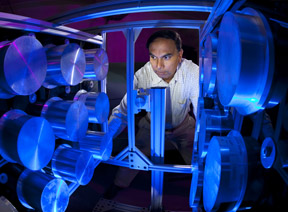
Faster, more accurate, portable, and safer — that’s been the evolution of the neutron scatter camera. In the year and a half since Nick Mascarenhas (8132) began testing his neutron scatter camera to detect special nuclear material in a variety of real-world scenarios, the instrument has met every challenge and its potential continues to grow (Lab News, Sept. 28, 2007).
The neutron scatter camera detects fast neutrons that emanate from special nuclear material to localize the source. Field tests have shown the instrument rejects naturally occurring background radiation that can obscure results from gamma ray detectors. Further simulation and testing have demonstrated the camera’s ability to cut through kitty litter, bananas, ceramics, and other sources of natural radiation that might be used to mask a source. Even steel is no match.
Last year, at the request of the Defense Threat Reduction Agency (DTRA), Nick tested the camera’s ability to detect from the shore a source inside the hold of a docked oil tanker. The neutron scatter camera measured neutrons at 20 times higher than background and detected a characteristic fission neutron energy spectrum through the ship’s hull. “It was surprising — in less than five minutes we had a beautiful image of the source in the ship,” he says. “It was a spectacular result.”
Nick and his team, Peter Marleau, Charles Greenberg, and Stan Mrowka (all 8132), and Jim Brennan (8621), have gotten better at analyzing the data the neutron scatter camera generates. The analysis tools can now reduce the size of the image, which is the position of the neutrons emanating from a source. In a sense, the analysis tool gives the neutron scatter camera a better resolution. “A smaller spot size means I can localize the source better,” he explains.
Recently, DTRA funded work to increase the number of scintillator-filled cell elements to a 12 by 12 array. The original configuration of the neutron scatter camera consisted of four by seven scintillator-filled cells to record interactions with the fast neutrons.
The scalability of the neutron scatter camera design — which Nick describes as like Lego blocks — makes these modifications simple. By increasing their number and size, the cells have more opportunities to react with the fast neutrons, resulting in shorter dwell times and longer stand-off distances.
In fact, the current configuration of the neutron scatter camera is 10 times more efficient than the version fielded last year. In a recent test conducted at
Livermore, the instrument was able to detect a source from a distance of more than 60 meters. “That’s huge,” says Nick. “At 60 to 100 meters, you go to something that could be put to use in a variety of scenarios.”
The camera was also able to resolve two sources simultaneously and a source that was being masked by naturally occurring radiation (in this case, a simulated truckload of 1,000 kilograms of kitty litter). This test demonstrates one of the neutron scatter camera’s advantages — it can cut through noise that would overwhelm gamma ray detectors and some neutron detectors.
In addition to field tests, Nick’s team has been simulating different camera configurations with more cells and increased volume. “We have not seen the end of this technology’s capability,” he says. “The predictions of what we could do with future incarnations are pretty impressive. We haven’t reached the end of the camera’s potential. I think imaging within seconds is feasible.”
With faster detection and a longer range, the potential uses for the camera begin to multiply. One of the first field tests for the camera was in-transit radiation detection on cargo ships traveling between Oakland, Calif., and Honolulu as part of George Lasche’s (6418) Experimental Limits for In-Transit Detection of Radiological Materials project (Lab News, Aug. 17, 2007).
Now, the camera could be suitable for point-of-entry detection and even at unmanned border crossings.
“One of my dreams is to see the camera deployed at a choke point such as the Panama Canal,” says Nick.
Another upgrade for the neutron scatter camera was portability, which in this case means it can be moved easily. The original version of the device, housed in a 40-foot sea-land container, was heavy, difficult to transport, and required an external AC power source. It also used a hazardous liquid scintillator that severely limited camera deployment.
Field testing is underway on the “portable” version housed in an 18-foot trailer with an AC generator that can provide power for up to eight hours and uses a safer liquid scintillator. It can be pulled by a pickup truck, versus a tractor trailer in the old configuration.
“The possibility of taking it anywhere you can drive a pickup truck really increases the potential audience for this device,” says Nick.
That potential audience has begun taking notice. Working with the business development office, he’s begun demonstrating the camera to potential industry partners to a very positive response.